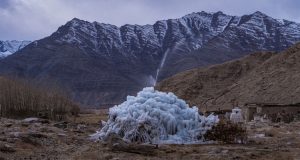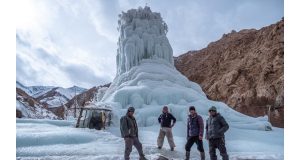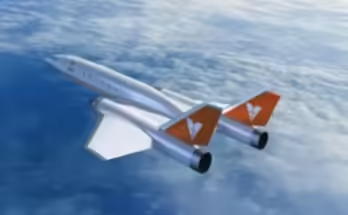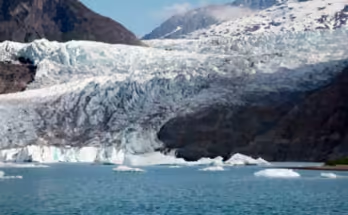by Sonam Wangchuk and HIAL Team
The “roof of the world”, the metaphorical description for the physio-geographic region encompassing the Indian Himalayas, is the site of vast freshwater glaciers and the primary source of the major Asian rivers that have sustained life since early human civilisations have inhabited the area. In modern times, these freshwater glaciers are still the primary source of water, and thus the welfare, for over a billion Asian people, especially for the tribal communities of Ladakh who have been perpetually dependent on glacial meltwater in the high-altitude desert.
Lying on the northerly fringes of the Himalayan watershed, Ladakh is characterised by distinct geographical and climatic features. Known as a cold desert, Ladakh covers an area of 96701 km2 and with an average elevation of 3000 m, having annual precipitation100 mm, and extreme temperatures ranges (-30 to 30 Co). Much of the province remains in a cold spell from October-March, with only a third of the year left for agrarian purposes. The villages in the region are settled in small oases in the barren desert, on the banks of a stream, or amongst springs utilising the summertime meltwater. Regardless of its ecosystem services and historical context, reckless human interventions and global climate change have impacted the region immeasurably, in particular, due to the escalated rate of warming at higher altitudes.
Currently, Himalayan glaciers are receding at an alarming rate, from a few to tens of meters annually. With reducing precipitation, increasing average temperatures, and reduced glaciers to water the villages anymore, some Himalayan villages are now slowly turning into ghost towns with abandoned but habitable houses and wasted agricultural land. This gives rise to three major modern issues of Ladakh relating to water scarcity, low indoor temperatures in buildings, and a shift from the original agrarian-based economy resulting into youth migration.
To address the emerging issues, Ministry of Tribal Affairs, Government of India (MoTA) in association with Himalayan Institute of Alternatives, Ladakh (HIAL) initiated a project for Research, Documentation and Development of Tribal communities of Ladakh in November 2019. One of the components of the project of critical importance is “Rehabilitation of Abandoned Villages through Ice Stupas”. This project has become a model of a collaborative effort between the local people, organisations with expertise and knowledge in this area, NGOs and the Government.
The idea and the 1st prototype Ice Stupa was made at SECMOL school in the winters of 2013. Taking inspiration from ancestral practices and Mr. Chewang Norphel’s work on artificial glaciers, Ice Stupas have been designed at various locations across Ladakh. With the combined efforts of MoTA and SECMOL, the project and art of glacier grafting has come a long way. While there was an Ice Stupa in 1 village in 2013-14; the knowledge, awareness and the art of building the structures were expanded to 26 locations across Ladakh in 2019-20.
Gathering support, ideas, and technological support from like-minded individuals and organisations has made immense improvement in the process of building Ice Stupas in India and abroad. In 2019-20 winters, the project was able to train 250 village-level stakeholders in the process and raising awareness on the issue by conducting various workshops, training sessions, and plantation drives across Ladakh. This year the project and participating villagers were able to conserve about 75 million liters of water during winters and eco-tourism activities like “1st Ladakh Ice Climbing Festival” gave the opportunity to the local youth to be indulged in eco-entrepreneurial ventures.
This year, the project started from the village of Kulum. It is situated 50 km south-east of Leh, divided into 2 hamlets, upper and lower Kulum, consisting of 7 and 4 families each respectively. Triggered by the glacial reduction in the higher valley, the upper Kulum was abandoned completely in 2012 with the families moving into the nearby town centre of Upshi. The residents have left their traditional agrarian practices and are working as daily wage labourers or are running utility shops to make ends meet. The project was implemented over a period of 4 months starting November 2019 to February 2020. Prior to implementation, field surveys and measurements were done, and a plan was formulated. This was followed by village and community level meetings to identify the needs and incorporate their ideas into the project. The plan was run by the villagers and their roles were defined so that this project can involve stakeholders and build competency in the former residents of Kulum.
In the first step of project implementation, the activities of equipment installation, head-work making, pipeline laying, and dome structures for Ice Stupas were completed with the help of residents of Kulum (locally called Kulumpa’s). This provided the villager’s hands-on experience of the process, thus inducing active participation at all stakeholder levels. During the course of the next few months until mid-February, a 45-foot-tall Ice Stupa was made by the upper hamlet of Kulum. A multitude of challenges arose, including freezing pipes, breaking equipment, bursting pipes, reduced flow at head-work emerged due to the extreme temperatures of Ladakhi winters, but each time a new solution was indigenously devised. The learnings for this year will become an asset for the next. By the end of the building season, the Ice Stupa structure was able to conserve 3,00,000 liters of water. This structure melted away in April end but provided much-needed water for the fields of Kulum. Confronting the issue of water scarcity and devising solutions has had a drastic impact on Kulumpa’s investment in the project.
In the coming years, the project envisions expanding its reach from water management strategies to a holistic village rehabilitation model. This model includes the following aspects;
- Upper Valley Plantation to act as a carbon sink and protection from flooding events
- Modern plantation and irrigational practices which are not as water-intensive like drip irrigation and hydroponic systems
- Alternative technologies for daily use, such as wind, solar, biogas, etc.





Image 1: Ice Stupa at Kulum village during the winters of 2019-20.
This structure at Kulum melted away in April end but provided much-needed water for the fields of Kulum. Confronting the issue of water scarcity and devising solutions has had a drastic impact on Kulumpa’s investment in the project.
These stupas are a source of tourist attraction and will go a long way in preserving the environment. The Ice Stupas hold the promise to not only quench the thirst of Ladakh tribal villages but also pave the way to make the tribal villagers AtmaNirbhar by facilitating their eco-rehabilitation to pursue any or new traditional livelihoods in their native villages only.
Image 2: Clockwise the Ice Stupas of Ladakh in 2019-20 season. The 1st , 2nd and 3rd biggest Ice Stupas from the villages of Igoo, Tarchit and Phyang. The last image shows a stack of Ice Stupas built in Gangles valley during an Ice Valley prototype project to conserve and later supply water for downstream villages and ultimately Leh city.
(Sonam Wangchuk is a famous Indian engineer, innovator and education reformist and founder member of HIAL. He is also the founding director of the Students’ Educational and Cultural Movement of Ladakh)



